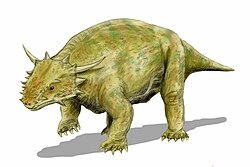| Parareptiles | |
|---|---|
 | |
| A collage of five parareptile fossils. Clockwise from top, Mesosaurus tenuidens (a mesosaur), Delorhynchus cifellii (a probable acleistorhinid), Scutosaurus karpinskii (a pareiasaur), Nyctiphruretus acudens (a nyctiphruretid), Hypsognathus fenneri (a procolophonid) | |
| Scientific classification | |
| Kingdom: | Animalia |
| Phylum: | Chordata |
| Class: | Reptilia |
| Subclass: | † Parareptilia Olson, 1947 |
| Subclades | |
| |
Parareptilia ("near-reptiles") is an extinct subclass of basal sauropsids ("reptiles"). Traditionally considered the sister taxon to Eureptilia (the group that likely contains all living reptiles and birds), some phylogenetic analyses now recognize it to be a paraphyletic assemblage of unrelated early reptiles. [1] [2] [3]
Contents
"Parareptiles" first arose near the end of the Carboniferous period and achieved their highest diversity during the Permian period. Several ecological innovations were first accomplished by "parareptiles" among reptiles. These include the first reptiles to return to marine ecosystems (mesosaurs), the first bipedal reptiles (bolosaurids such as Eudibamus ), the first reptiles with advanced hearing systems (nycteroleterids and others), and the first large herbivorous reptiles, the pareiasaurs, the largest of which reached the sized of oxen. The only "parareptiles" to survive into the Triassic period were the procolophonoids, a group of small lizard-like generalists, omnivores, and herbivores. The largest family of procolophonoids, the procolophonids, rediversified in the Triassic, but subsequently declined and became extinct by the end of the period. [4] [5]
Compared to most "eureptiles", "parareptiles" retained fairly "primitive" characteristics such as robust, low-slung bodies and large supratemporal bones at the back of the skull. While all but the earliest eureptiles were diapsids, with two openings at the back of the skull, "parareptiles" were generally more conservative in the extent of temporal fenestration. In its modern usage, Parareptilia was first utilized as a cladistically correct alternative to Anapsida, a term which historically referred to reptiles with solid skulls lacking holes behind the eyes. [6] Nevertheless, not all "parareptiles" have "anapsid" skulls, and some do have large holes in the back of the skull. They also had several unique adaptations, such as a large pit on the maxilla, a broad prefrontal-palatine contact, and the absence of a supraglenoid foramen of the scapula. [6] [7]
Like many other so-called "anapsids", "parareptiles" were historically understudied. Interest in their relationships was reinvigorated in the 1990s, when several studies argued that Testudines (turtles and their kin) were members of Parareptilia. [6] Although this would suggest that Parareptilia was not extinct after all, the origin of turtles is still heavily debated. Many other morphological or genetic analyses find more support for turtles among diapsid eureptiles such as sauropterygians or archosauromorphs, rather than "parareptiles". [8] [9] [10] [5]
Several studes from the early 2020s have suggested that "Parareptilia" is not a monophyletic clade but a paraphyletic grade of primitive sauropsids, with some "parareptiles" more closely related to modern reptiles than to other "parareptilians". [1] [2]



















